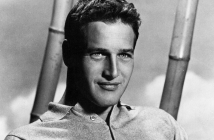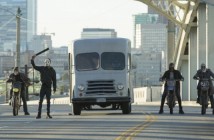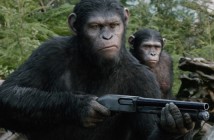Every ten years the venerable British film periodical Sight & Sound (run by the British Film Institute) polls an esteemed collection of critics and, since 1992, directors to codify a consensus list of “greatest films of all time.” 2012 happens to be a poll year, and many critics and bloggers, whether contacted for inclusion by the BFI or not, have weighed in with their choices. Conveniently, the respondents are supposed to list their personal Top Ten, and that’s my raison d’être! Somehow my ballot got lost in the mail, so instead for this Top Ten Tuesday I’ll present a completely hypothetical, wholly polemical listing for ten of my favorite movies that I’m feeling right now and need to be recognized. Here we go.
10. Begone Dull Care (1949)
A lively, abstract short music video of sorts featuring the music of the incomparable Oscar Peterson trio, Begone Dull Care by Canadian animators Norman McLaren and Evelyn Lambart, viewable at the Film Board of Canada’s website, is an engrossing, foot-tapping amalgam of sight and sound. The filmmakers etched directly onto the film material to create the bouncing colored shapes and lines that appear, collide, and disappear to the music’s three movements, each in a different tempo but loosely tied together by the theme of visual accompaniment to the thoroughly non-visual. The Sight & Sound poll remains extremely live-action feature-centric, so a blast of jazzy animation would do the old canon some good.
 9. Monsieur Verdoux (1947)
9. Monsieur Verdoux (1947)
Despite a poor reception from the postwar American audience of 1947 (save perceptive reviews from the likes of James Agee), Charlie Chaplin’s pitch-black moralistic comedy Monsieur Verdoux has slowly grown in stature since. Having tackled Hitler in The Great Dictator, few were expecting the sheer gall on display by the single most popular film star in the world in portraying an aging former bank clerk insinuating himself into the lives of wealthy widows, only to rob and murder them. Verdoux (inspired by the “French Bluebeard” Landru) is the dark underside of Chaplin’s classic Tramp persona, as meticulously groomed and witty as the Tramp was disheveled and silent, yet they both share a keen sense of survival within the machinations of modern life (or Modern Times). Chaplin calls back to the economic catastrophes of an earlier era, the Depression of the 1930s, to intertwine the worlds of business in murder, famously declaring that “One murder makes a villain; millions, a hero. Numbers sanctify,” a ruthlessly leftist tonic to the immediate postwar years. It took a great artist to subvert such a successful persona and to sacrifice laughs for harsh truths.
8. Cops (1922)
As funny and brutally anarchic as anything Buster Keaton ever produced, his 1922 short Cops (co-directed with Eddie Cline and watchable on youTube) is like a comedy L’Argent, showing money’s destructive tendencies and an escalation of misunderstandings involving financial transactions and the law. Buster, as always, pines for a girl, who brushes him off until he becomes a real businessman, leading to several reversals of fortune for Keaton’s underdog. He returns then swipes the dropped wallet of an ungrateful rich man but then gets one-upped by a con man apparently down on his luck. Buster’s misadventures with an illegally-bought set of furniture on a carriage drawn by an unruly horse inevitably leads to a policemen parade and a random anarchist bomb thrower. What follows is one of the greatest chase scenes of all time, aided immeasurably by Keaton’s visual wit and sense of comedy in depth, his protagonist on the run from a cacophony of cops that out-Keystones Keystone. Cops is a tour de force of physical comedy and invention that ends with a bizarre but somehow inevitably nasty sting.
 7. The Funeral (1984)
7. The Funeral (1984)
I include Jûzô Itami’s scathing Tampopo (1985) on my list of favorite Japanese films, but for my Sight & Sound list I’d like to bring his 1984 debut The Funeral to the fore. As much as in his next film, Itami satirizes the modern Westernization of Japanese society, its lack of connection to traditional culture, through a comic portrayal of preparations for the funeral ritual and an ill-timed kind of family reunion. Tampopo stars Nobuko Miyamoto and Tsutomu Yamazaki are here the ill-prepared couple whose father passes away and is the subject of the funeral, and the film chronicles their unsteady path towards preparing his proper Buddhist rite. The Funeral sacrifices the outright farcical moments of Tampopo in order to highlight the emotional undercurrents of the situation, including the funny-yet-sad sight of having to watch a VHS tape on funeral etiquette. The film’s heartfelt balance of dark humor and affection mark the passing of the seemingly barely-beloved patriarch, whose death becomes the vehicle for his relatives’ reflections on their own lives and mortality, an extraordinary feat for a filmmaker’s debut.
6. Welfare (1975)
In a directorial career spanning 45 years, Frederick Wiseman has portrayed the world one institution at a time, beginning with 1967’s harrowing Titicut Follies, set in a Massachusetts mental institution, to last year’s portrait of a Parisian cabaret, Crazy Horse. My choice is in between, Welfare, an almost-three hour look at the New York welfare system in the mid-1970s. It contains all the hallmarks of Wiseman’s studious style: lack of commentary or music; a lack of obvious editorial bias; and images of ordinary people caught up in the system and those working to do good from within. Never one to court controversy, Wiseman in Welfare avoids the obvious pitfalls in the debate over public assistance by giving everyone their due, editing without preconceived notions or an ax to grind against either the welfare state or those who would label it unfair. The camera captures a myriad of cases, both personal tragedies and attempted abuses of the system, without highlighting one type of event over another, leaving the audience, affected by the range of individual lives (Wiseman’s real subjects, more so than the monolithic institutions he’s normally charged with chronicling) on display, to wrestle to its own conclusion.
 5. A Man Escaped (1956)
5. A Man Escaped (1956)
So many of Robert Bresson’s films are beloved to me, but A Man Escaped usually stands out for the intersection of the filmmaker’s trademark purity of style and the prison escape genre’s elements of suspense. François Leterrier plays Fontaine, a condemned member of the French Resistance whole sole task in the film is to escape, an intensity of purpose against overwhelming odds that ties him to other Bresson protagonists yet keeps him more identifiable to the audience. The camera closely observes Fontaine as he sizes up his situation at every moment he can, transporting the viewer into his physical space through isolation and an absolutely fidelity to realistic gesture and experience, broken only by the Mozart music that adds an extra dimension to his plight, making his escape a spiritual as well as physical transcendence. Few films are as beautifully focused and single-minded as Bresson’s masterpiece, forceful and serious and ultimately uplifting and engulfing.
4. À propos de Nice (1930)
Although his last and only feature-length film, L’Atalante, has the best chance of making it into the Sight & Sound results (and did earlier in 1962 and in 1992), Jean Vigo’s rightful place on my hypothetical ballot will be taken up by his short “documentary” À propos de Nice. A “city symphony” à la Man with a Movie Camera or Berlin: Symphony of a Great City, the film is a sharply satirical tour of the French seaside city; Vigo’s main collaborator and cinematographer was, incidentally, the younger brother of Movie Camera filmmaker Dziga Vertov, Boris Kaufman. Instead of showcasing modernist urban efficiency and the smooth alignment of the metropolis’s many moving parts, however, Vigo highlights the vulgarity and wastefulness of the idle bystanders, match cutting them to ostriches and crocodiles. The film contrasts the grotesquely comical rich to the little-acknowledged underclass, a gaudy and raucous parade to a cemetery, all captured with both hidden and obvious cameras. Groundbreaking as a stylized social document and still wildly invigorating, borderline revolutionary in look and feel, Vigo’s debut has more caustic wit and verve than would be expected in its mere twenty-five minute running time.
 3. Freaks (1932)
3. Freaks (1932)
Audaciously humanistic and compassionate, Tod Browning’s Freaks could not have been made at any time but the relatively unrestricted Pre-Code era of Hollywood history, a time when a studio like MGM could release a film whose subject would later seem like the province of a cheap exploitation studio. Peopled mostly with real circus performers, the de facto “freaks” of the title are treated more casually and sympathetically than the seemingly “normal” villains, whose moral deformities enormously outweigh the protagonists’ physical ones. Although Freaks was subsequently taken up as a classic of “schlock cinema,” its true radicalness lies in putting its characters on the same emotional and behavioral terrain as any characters in a contemporary melodrama, neither condescending to them nor, at least until the shuddering climax, making them wholly “other.” Freaks has been rightly taken up as a touchstone for generations of perpetual outsiders and misfits who nonetheless recognize their shared humanity.
2. A Moment of Innocence (1996)
The so-called Iranian “new wave” that began in the late 1960s has seemingly yet to wither, buoyed since by the likes of Kiarostami, Kimiavi, Panahi, Majidi, and others; one of my favorites is certainly Mohsen Makhmalbaf, whose self-reflexive, semi-autobiographical films embody a humanistic combination of affectioning and questioning of Iranian culture. My favorite film of his seen so far is the mid-90s’ A Moment of the Innocence (alternatively known as Bread and Flower or The Bread and the Vase, fittingly dualistic titles), a meta-reflection similar to Kiarostami’s Close-Up concerning Makhmalbaf casting a film based on his experience as a teenager being jailed for stabbing a young policeman at a protest rally against the Shah. The writer-director-actor-editor dazzlingly introduces multiple points of view by finding that policeman years later and allowing him to cast the young version of himself in the film, opening up the past and his own memory to investigation. Sidestepping the chances for sentimentality or didacticism, Makhmalbaf weaves together a more down-to-earth story of the young actors involved, including an actress playing a girl known to both men at the time of the incident. The film remains a hallmark of Iranian cinema in its melding of attempted historical self-understanding and deeply human-level storytelling.
 1. Playtime (1967)
1. Playtime (1967)
When Criticwire recently published a survey of what film from the 2002 Sight & Sound poll should be removed and what film should be added into its place, the title of Jacques Tati’s Playtime appeared in multiple suggestions for the newly-added film. It will also be my foremost choice; Tati’s masterpiece is a comic universe unto itself, a meticulously-constructed personal project that failed at the box office and more or less halted Tati’s career in its tracks. Much has been written about Tati’s evolution of scale from 1949’s relatively parochial Jour de fête to the edifice of Tativille constructed for Playtime, yet all the films are marvels of cinematic construction and comedic possibility at any budget. The film is undoubtedly a peak of visual wit, full of sight and sound gags both obvious and subtle, and blessed with a surfeit of modernist ideas that repay close and repeated viewings. Playtime only managed three votes in the 2002 poll (from Olivier Assayas, Jonathan Rosenbaum, and the late Gilbert Adair), so it sadly looks to still be likely absent from this year’s results.



